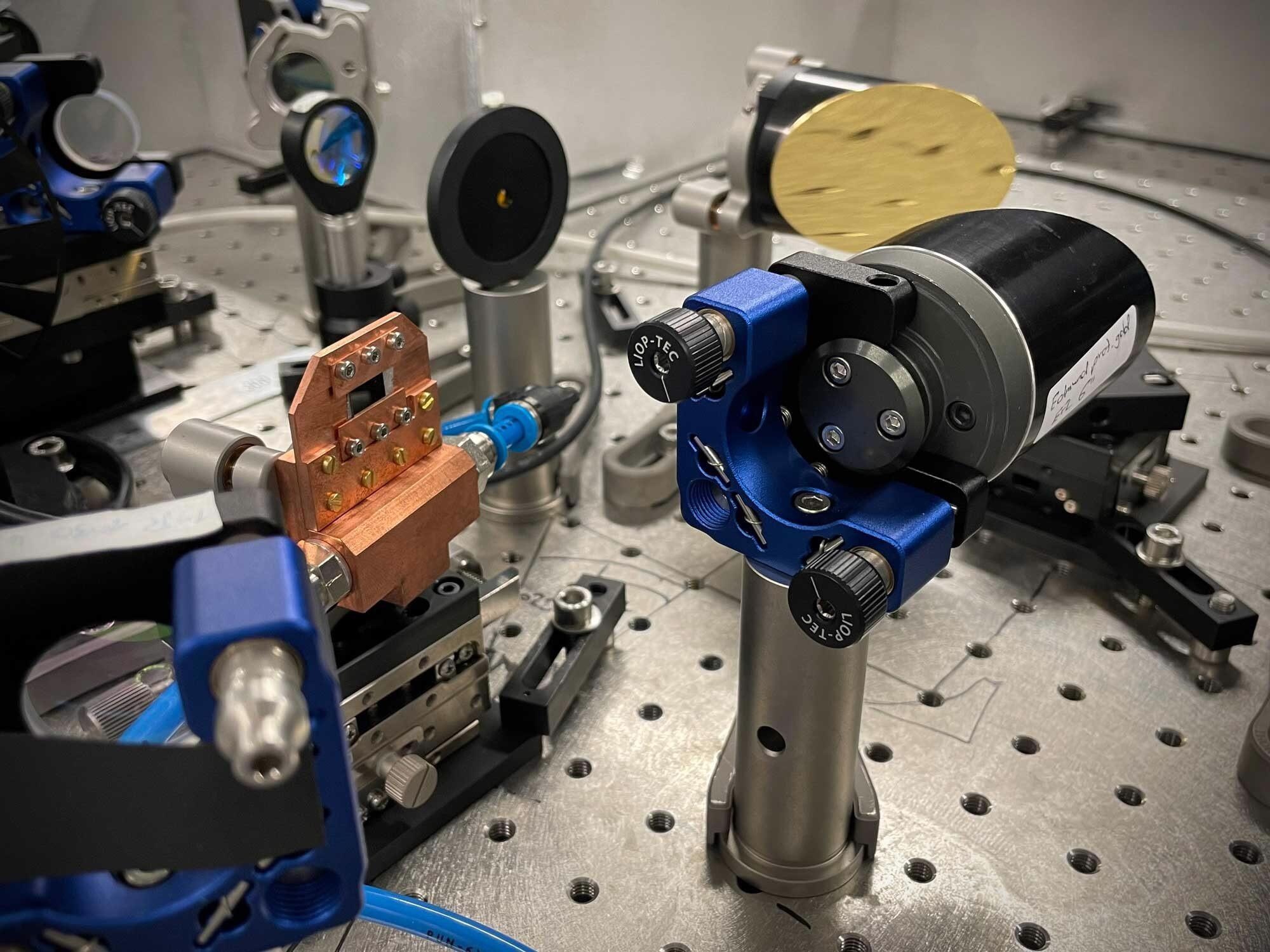A laser pulse working around the intrinsic symmetry of light waves could potentially modify quantum information, helping to make room-temperature quantum computing more of a reality.
 The semiconductor nanosheets in the water-cooled copper mount turn an infrared laser pulse into an effectively unipolar terahertz pulse. The team says that their terahertz emitter could be made to fit inside a matchbox. Image Credit: Christian Meineke, Huber Lab, University of Regensburg.
The semiconductor nanosheets in the water-cooled copper mount turn an infrared laser pulse into an effectively unipolar terahertz pulse. The team says that their terahertz emitter could be made to fit inside a matchbox. Image Credit: Christian Meineke, Huber Lab, University of Regensburg.
The study, undertaken by experts from the Universities of Regensburg and Michigan, could potentially speed up traditional computing.
Quantum computing offers the potential to speed up answers to issues that need simultaneous exploration of several factors, such as medicine development, weather prediction, and cybersecurity encryption.
Quantum bits, or qubits, can encode both 1 and 0 simultaneously, unlike traditional computer bits, effectively allowing quantum computers to run through numerous possibilities at the same time. However, these mixed states do not last for very long, so the information processing must be faster than electronic circuits can muster.
Although laser pulses can be used to control the energy states of qubits, other types of computing—including a room-temperature approach—are feasible if charge carriers used to encode quantum information can be moved freely.
Terahertz light, lying between infrared and microwave radiation, oscillates quickly to achieve the required speed, but the wave’s form is a concern. In other words, electromagnetic waves must cause both positive and negative oscillations that add up to zero.
The positive cycle has the potential to transfer charge carriers like electrons. The negative cycle, however, draws the charges back to where they began. An asymmetric light wave is required to successfully control quantum information.
The optimum would be a completely directional, unipolar ‘wave’, so there would be only the central peak, no oscillations. That would be the dream. But the reality is that light fields that propagate have to oscillate, so we try to make the oscillations as small as we can.
Mackillo Kira, Professor, Electrical Engineering and Computer Science, University of Michigan
Their findings were published in Light: Science & Applications.
Since only positive or negative waves are absolutely impossible, the global team devised a method to achieve the next best thing. They effectively formed a unipolar wave with a strong positive peak of high amplitude bordered by two lengthy negative peaks of low amplitude.
As a result, the positive peak is powerful enough to transport charge carriers, whereas the negative peaks are insignificant.
They achieved this by carefully designing terahertz emission through the migration of electrons and holes, which are the voids left behind when electrons travel in semiconductors. Dominique Bougeard, a physics professor at the University of Regensburg in Germany, created the nanosheets, which are roughly a thousandth of a hair thick.
The semiconductor nanosheets were then piled in front of a laser by Rupert Huber’s group, who is also a professor of physics at the University of Regensburg. The nanosheet generated electrons when the near-infrared pulse hit it. Due to the nanosheets’ architecture, the electrons welcomed the separation from the holes and accelerated forward.
The electrons were then pulled back by the holes. The energy gathered from the laser pulse was released as a strong positive terahertz half-cycle preceded and followed by a faint, lengthy negative half-cycle when the electrons rejoined the holes.
The resulting terahertz emission is stunningly unipolar, with the single positive half-cycle peaking about four times higher than the two negative ones. We have been working for many years on light pulses with fewer and fewer oscillation cycles. The possibility of generating terahertz pulses so short that they effectively comprise less than a single half-oscillation cycle was beyond our bold dreams.
Rupert Huber, Professor, Physics, University of Regensburg
The team then plans to influence electrons in room-temperature quantum materials using these pulses in order to investigate quantum information processing methods. The pulses might potentially be utilized to process traditional data at ultrafast speeds.
Now that we know the key factor of unipolar pulses, we may be able to shape terahertz pulses to be even more asymmetric and tailored for controlling semiconductor qubits.
Qiannan Wen, Co first Author and PhD Student, Applied Physics, University of Michigan
The experiment and characterization of the nanosheets were supported by collaborators from Justus Liebig University Giessen and Helmut Schmidt University, both in Germany.
The German Research Foundation (DFG), the W.M. Keck Foundation, and the National Science Foundation contributed to this study.
Journal Reference:
Meineke, C, et al. (2022) Scalable high-repetition-rate sub-half-cycle terahertz pulses from spatially indirect interband transitions. Light: Science & Applications doi:10.1038/s41377-022-00824-6.